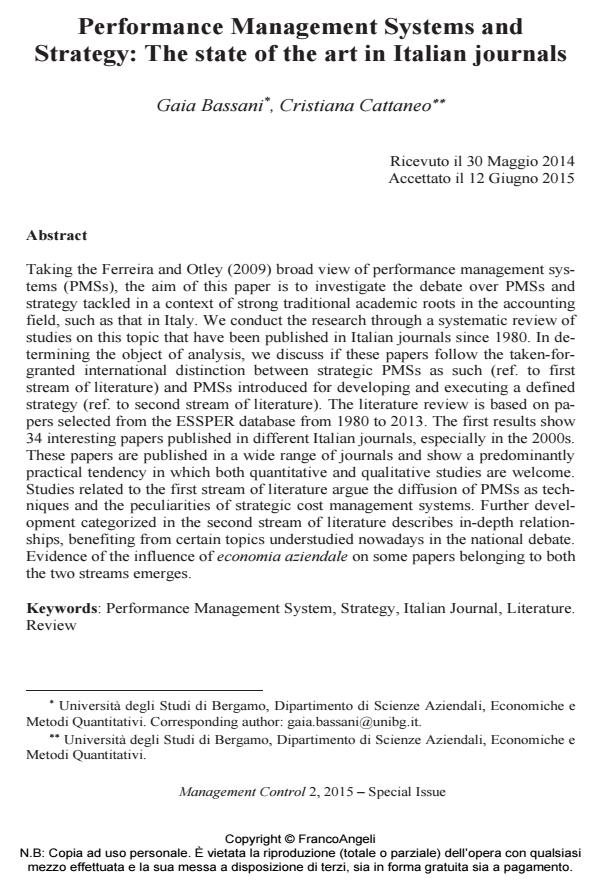Performance Management Systems and Strategy: The state of the art in Italian journals
Journal title MANAGEMENT CONTROL
Author/s Gaia Bassani, Cristiana Cattaneo
Publishing Year 2015 Issue 2015/2
Language English Pages 28 P. 13-40 File size 158 KB
DOI 10.3280/MACO2015-002002
DOI is like a bar code for intellectual property: to have more infomation
click here
Below, you can see the article first page
If you want to buy this article in PDF format, you can do it, following the instructions to buy download credits

FrancoAngeli is member of Publishers International Linking Association, Inc (PILA), a not-for-profit association which run the CrossRef service enabling links to and from online scholarly content.
Taking the Ferreira and Otley (2009) broad view of performance management systems (PMSs), the aim of this paper is to investigate the debate over PMSs and strategy tackled in a context of strong traditional academic roots in the accounting field, such as that in Italy. We conduct the research through a systematic review of studies on this topic that have been published in Italian journals since 1980. In determining the object of analysis, we discuss if these papers follow the taken-forgranted international distinction between strategic PMSs as such (ref. to first stream of literature) and PMSs introduced for developing and executing a defined strategy (ref. to second stream of literature). The literature review is based on papers selected from the ESSPER database from 1980 to 2013. The first results show 34 interesting papers published in different Italian journals, especially in the 2000s. These papers are published in a wide range of journals and show a predominantly practical tendency in which both quantitative and qualitative studies are welcome. Studies related to the first stream of literature argue the diffusion of PMSs as techniques and the peculiarities of strategic cost management systems. Further development categorized in the second stream of literature describes in-depth relationships, benefiting from certain topics understudied nowadays in the national debate. Evidence of the influence of economia aziendale on some papers belonging to both the two streams emerges.
Keywords: Performance Management System, Strategy, Italian Journal, Literature. Review
- Misure di performance innovative e modelli di business: il caso delle aziende aeroportuali italiane Vincenzo Fasone, Mariano Puglisi, in MANAGEMENT CONTROL 2/2017 pp.71
DOI: 10.3280/MACO2017-002005 - Sustainability Reporting and Performance Measurement Systems: How do Small- and Medium-Sized Benefit Corporations Manage Integration? Giorgia Nigri, Mara Del Baldo, in Sustainability /2018 pp.4499
DOI: 10.3390/su10124499 - The strength of weak rings: Teams performance measurement and management in sport Raffaele Trequattrini, Alessandra Lardo, Benedetta Cuozzo, Alberto Manzari, Pavlo Brin, in MANAGEMENT CONTROL 3/2021 pp.135
DOI: 10.3280/MACO2021-003007
Gaia Bassani, Cristiana Cattaneo, Performance Management Systems and Strategy: The state of the art in Italian journals in "MANAGEMENT CONTROL" 2/2015, pp 13-40, DOI: 10.3280/MACO2015-002002